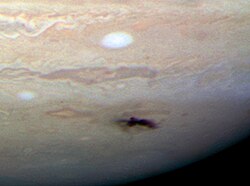Portal:Jupiter/Radiation astronomy/1
Meteors
[edit | edit source]


Jupiter has been called the Solar System's vacuum cleaner,[2] because of its immense gravity well and location near the inner Solar System. It receives the most frequent comet impacts of the Solar System's planets.[3]
A 1997 survey of historical astronomical drawings suggested that the astronomer Cassini may have recorded an impact scar in 1690. The survey determined eight other candidate observations had low or no possibilities of an impact.[4] A fireball was photographed by Voyager 1 during its Jupiter encounter in March 1979.[5] During the period July 16, 1994, to July 22, 1994, over 20 fragments from the comet Shoemaker–Levy 9 (SL9, formally designated D/1993 F2) collided with Jupiter's southern hemisphere, providing the first direct observation of a collision between two Solar System objects. This impact provided useful data on the composition of Jupiter's atmosphere.[6][7]
On July 19, 2009, an impact site was discovered at approximately 216 degrees longitude in System 2.[8][9] This impact left behind a black spot in Jupiter's atmosphere, similar in size to Oval BA. Infrared observation showed a bright spot where the impact took place, meaning the impact warmed up the lower atmosphere in the area near Jupiter's south pole.[10]
A fireball, smaller than the previous observed impacts, was detected on June 3, 2010, by Anthony Wesley, an amateur astronomer in Australia, and was later discovered to have been captured on video by another amateur astronomer in the Philippines.[11] Yet another fireball was seen on August 20, 2010.[12]
On September 10, 2012, another fireball was detected.[5][13]
The second image at right shows the atmospheric impact sites for the Comet Shoemaker-Levy 9 fragments. Spectroscopic studies revealed absorption lines in the Jovian spectrum due to diatomic sulfur (S2) and carbon disulfide (CS2), the first detection of either in Jupiter, and only the second detection of S2 in any astronomical object. Other molecules detected included ammonia (NH3) and hydrogen sulfide (H2S). The amount of sulfur implied by the quantities of these compounds was much greater than the amount that would be expected in a small cometary nucleus, showing that material from within Jupiter was being revealed.
"A false-color composite image [first on the left] of Jupiter and its South Equatorial Belt shows an unusually bright spot, or outbreak, where winds are lofting particles to high altitudes in this image made from data obtained by the W.M. Keck telescope on Nov. 11, 2010."[14]
"The white clouds [in the second image down on the left], which get up to 50 miles (80 kilometers) wide or so, are high up in Jupiter's atmosphere — so high that they're very cold, and the material they shed is therefore almost certainly frozen."[15]
"It's snowing on Jupiter, and we're seeing how it works."[15]
"It's probably mostly ammonia ice, but there may be water ice mixed into it, so it's not exactly like the snow that we have [on Earth]. And I was using my imagination when I said it was snowing there — it could be hail."[15]
"This photo taken by NASA’s Juno spacecraft on May 19, 2017, at 5:50 UTC from an altitude of 5,500 miles (8,900 kilometers) shows high-flying white clouds composed of water ice and/or ammonia ice. In some areas, these clouds appear to form squall lines — narrow bands of high winds and storms associated with a cold front."[15]
References
[edit | edit source]- ↑ Dennis Overbye (24 July 2009). Hubble Takes Snapshot of Jupiter’s ‘Black Eye’. New York Times. http://www.nytimes.com/2009/07/25/science/space/25hubble.html?ref=science. Retrieved 25 July 2009.
- ↑ Richard A. Lovett (15 December 2006). Stardust's Comet Clues Reveal Early Solar System. National Geographic News. http://news.nationalgeographic.com/news/2006/12/061215-comet-stardust.html. Retrieved 8 January 2007.
- ↑ Nakamura, T.; Kurahashi, H. (1998). "Collisional Probability of Periodic Comets with the Terrestrial Planets: An Invalid Case of Analytic Formulation". Astronomical Journal 115 (2): 848–54. doi:10.1086/300206. http://www.iop.org/EJ/article/1538-3881/115/2/848/970144.html. Retrieved 2007-08-28.
- ↑ Tabe, Isshi; Watanabe, Jun-ichi; Jimbo, Michiwo (February 1997). "Discovery of a Possible Impact SPOT on Jupiter Recorded in 1690". Publications of the Astronomical Society of Japan 49: L1–L5.
- ↑ 5.0 5.1 Franck Marchis (10 September 2012). Another fireball on Jupiter?. Cosmic Diary blog. http://cosmicdiary.org/fmarchis/2012/09/10/another-fireball-on-jupiter/. Retrieved 11 September 2012.
- ↑ Ron Baalke. Comet Shoemaker-Levy Collision with Jupiter. NASA. http://www2.jpl.nasa.gov/sl9/. Retrieved 2007-01-02.
- ↑ Robert R. Britt (23 August 2004). Remnants of 1994 Comet Impact Leave Puzzle at Jupiter. space.com. http://www.space.com/scienceastronomy/mystery_monday_040823.html. Retrieved 20 February 2007.
- ↑ Staff (21 July 2009). Amateur astronomer discovers Jupiter collision, In: ABC News online. http://www.abc.net.au/news/stories/2009/07/21/2632368.htm. Retrieved 21 July 2009.
- ↑ Mike Salway (19 July 2009). Breaking News: Possible Impact on Jupiter, Captured by Anthony Wesley, In: IceInSpace News. IceInSpace. http://www.iceinspace.com.au/index.php?id=70,550,0,0,1,0. Retrieved 19 July 2009.
- ↑ Grossman, Lisa (July 20, 2009). "Jupiter sports new 'bruise' from impact". New Scientist. http://www.newscientist.com/article/dn17491-jupiter-sports-new-bruise-from-impact.html.
- ↑ Michael Bakich (4 June 2010). Another impact on Jupiter. Astronomy Magazine online. http://www.astronomy.com/asy/default.aspx?c=a&id=9918. Retrieved 4 June 2010.
- ↑ Beatty Kelly (22 August 2010). Another Flash on Jupiter!. Sky Publishing. http://web.archive.org/web/20100827180208/http://www.skyandtelescope.com/community/skyblog/observingblog/101264994.html. Retrieved 23 August 2010. "Masayuki Tachikawa was observing ... 18:22 Universal Time on the 20th ... Kazuo Aoki posted an image ... Ishimaru of Toyama prefecture observed the event"
- ↑ George Hall (September 2012). George's Astrophotography. http://georgeastro.weebly.com/jupiter.html. Retrieved 17 September 2012. "10 Sept. 2012 11:35 UT .. observed by Dan Petersen"
- ↑ Nancy Atkinson (24 December 2015). How Jupiter is Getting Its Belt Back. Universe Today. http://www.universetoday.com/79931/how-jupiter-is-getting-its-belt-back/. Retrieved 12 February 2017.
- ↑ 15.0 15.1 15.2 15.3 Scott Bolton (30 May 2017). 'It's Snowing on Jupiter': Stunning Photos Show Clouds High in Gas Giant's Skies. Space.com. http://www.space.com/37009-jupiter-snow-high-clouds-juno-photos.html. Retrieved 4 June 2017.
